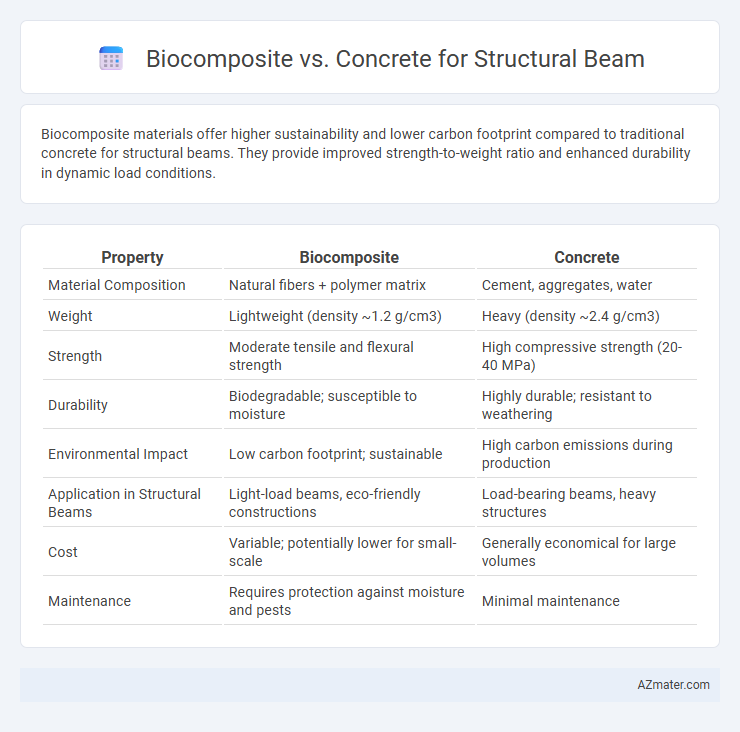Biocomposite materials offer higher sustainability and lower carbon footprint compared to traditional concrete for structural beams. They provide improved strength-to-weight ratio and enhanced durability in dynamic load conditions.
Table of Comparison
| Property | Biocomposite | Concrete |
|---|---|---|
| Material Composition | Natural fibers + polymer matrix | Cement, aggregates, water |
| Weight | Lightweight (density ~1.2 g/cm3) | Heavy (density ~2.4 g/cm3) |
| Strength | Moderate tensile and flexural strength | High compressive strength (20-40 MPa) |
| Durability | Biodegradable; susceptible to moisture | Highly durable; resistant to weathering |
| Environmental Impact | Low carbon footprint; sustainable | High carbon emissions during production |
| Application in Structural Beams | Light-load beams, eco-friendly constructions | Load-bearing beams, heavy structures |
| Cost | Variable; potentially lower for small-scale | Generally economical for large volumes |
| Maintenance | Requires protection against moisture and pests | Minimal maintenance |
Introduction to Structural Beam Materials
Structural beam materials significantly influence load-bearing capacity and durability in construction projects. Biocomposite beams, composed of natural fibers and polymer matrices, offer advantages like reduced weight, improved sustainability, and corrosion resistance compared to traditional concrete beams. Concrete beams, widely used for their high compressive strength and fire resistance, remain dominant but face challenges in environmental impact and susceptibility to cracking under tensile stress.
Overview of Biocomposite Materials
Biocomposite materials for structural beams combine natural fibers such as hemp, flax, or sisal with polymer or cementitious matrices, offering a sustainable alternative to traditional concrete. These composites provide benefits including reduced weight, enhanced thermal insulation, and improved resistance to corrosion and cracking compared to conventional concrete beams. Advances in fiber treatment and matrix formulation have improved the mechanical properties and durability of biocomposites, making them increasingly viable for load-bearing structural applications.
Concrete as a Traditional Structural Material
Concrete has long been the fundamental material for structural beams due to its high compressive strength, durability, and cost-effectiveness, making it ideal for supporting heavy loads in construction. Its well-established manufacturing process and widespread availability ensure consistent quality and performance across various projects. Although biocomposites offer sustainability benefits, concrete remains dominant for structural applications because of its proven reliability and structural integrity.
Mechanical Properties: Strength and Stiffness Comparison
Biocomposite beams exhibit high strength-to-weight ratios with tensile strengths typically ranging from 50 to 150 MPa, making them competitive with traditional concrete, which has compressive strengths between 20 to 40 MPa but lower tensile capacity. The stiffness of biocomposites depends on fiber type and orientation, often achieving Young's moduli of 10 to 30 GPa, whereas concrete offers higher compressive stiffness around 25 to 40 GPa but limited flexural performance. These mechanical properties indicate biocomposites can provide enhanced flexibility and impact resistance for structural beams, while concrete remains superior in compressive load-bearing applications.
Durability and Longevity Analysis
Biocomposite structural beams exhibit enhanced durability due to their resistance to corrosion, moisture absorption, and chemical degradation compared to traditional concrete. Studies show biocomposites maintain mechanical integrity over extended periods under environmental stress, reducing maintenance costs and prolonging service life. Concrete beams, while strong, often suffer from cracking and reinforcement corrosion, limiting their longevity in aggressive environments.
Environmental Impact and Sustainability
Biocomposite structural beams significantly reduce carbon emissions compared to traditional concrete by utilizing renewable natural fibers and bio-based resins, promoting carbon sequestration during growth. Concrete production, particularly cement manufacturing, contributes approximately 8% of global CO2 emissions, highlighting its environmental burden and extraction impacts on ecosystems. Biocomposites offer enhanced sustainability through biodegradability and lower energy consumption in production, supporting circular economy principles in construction.
Cost and Economic Feasibility
Biocomposite beams offer a cost advantage through lower material and transportation expenses compared to traditional concrete, which requires expensive cement production and curing processes. Economic feasibility analysis highlights biocomposites' potential for reduced life-cycle costs due to their lightweight nature, reducing foundation and installation costs. However, concrete remains widely preferred for large-scale structural beams because of its established supply chain and durability, making it more economically viable for heavy-load applications despite higher initial costs.
Construction and Fabrication Methods
Biocomposite structural beams utilize natural fibers embedded in a polymer matrix, allowing for lightweight, corrosion-resistant components fabricated through processes like compression molding or pultrusion. Concrete beams rely on casting or precasting methods involving formwork and steel reinforcement, offering high compressive strength but increased weight and longer curing time. Choosing between biocomposite and concrete in construction demands consideration of fabrication speed, environmental impact, and mechanical properties specific to project requirements.
Performance in Real-World Applications
Biocomposite structural beams exhibit enhanced tensile strength and superior corrosion resistance compared to traditional concrete, making them ideal for environments with high moisture exposure. Concrete beams offer excellent compressive strength and durability under heavy loads but are prone to cracking and require frequent maintenance in freeze-thaw cycles. Real-world applications demonstrate biocomposites' lightweight properties reduce load on foundations while sustaining long-term structural integrity, whereas concrete remains preferred for its fire resistance and cost-effectiveness in large-scale construction.
Future Trends and Innovations in Structural Materials
Biocomposite structural beams are rapidly gaining attention due to their sustainability, lightweight properties, and enhanced strength-to-weight ratio compared to traditional concrete, positioning them as a key innovation in green construction. Advanced bio-based resins and natural fiber reinforcements, coupled with 3D printing technologies, are driving significant improvements in durability, flexibility, and environmental impact reduction. Future trends emphasize hybrid materials combining biocomposites with concrete to optimize load-bearing capacity while minimizing carbon footprint, paving the way for more resilient and eco-friendly structural frameworks.

Infographic: Biocomposite vs Concrete for Structural beam
 azmater.com
azmater.com